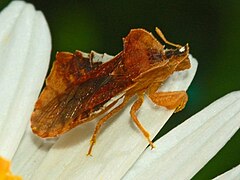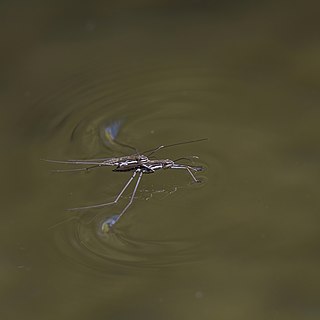
The Gerridae are a family of insects in the order Hemiptera, commonly known as water striders, water skeeters, water scooters, water bugs, pond skaters, water skippers, water gliders, water skimmers or puddle flies. Consistent with the classification of the Gerridae as true bugs, gerrids have mouthparts evolved for piercing and sucking, and distinguish themselves by having the unusual ability to walk on water, making them pleuston (surface-living) animals. They are anatomically built to transfer their weight to be able to run on top of the water's surface. As a result, one could likely find water striders present in any pond, river, or lake. Over 1,700 species of gerrids have been described, 10% of them being marine.
The arthropod leg is a form of jointed appendage of arthropods, usually used for walking. Many of the terms used for arthropod leg segments are of Latin origin, and may be confused with terms for bones: coxa, trochanter, femur, tibia, tarsus, ischium, metatarsus, carpus, dactylus, patella.

Reduvius personatus or the masked hunter is an insect belonging to the assassin bug (Reduviidae) family. The name is because its nymphs camouflage themselves with dust. The masked hunter is a predator of small arthropods, including woodlice, lacewings, earwigs, bed bugs and termites. Masked hunters do not feed on human blood, but can sting humans in self-defense when mishandled. The sting can be painful, but masked hunters do not carry Chagas disease unlike the kissing bug for which they are sometimes mistaken.
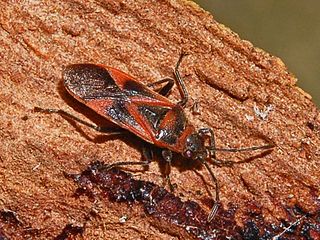
Arocatus roeselii is a species of lygaeid bug.

Idolomantis is a monotypic genus of praying mantises in the family Empusidae. It contains the single species, Idolomantis diabolica, commonly known as the devil's flower mantis or giant devil's flower mantis. It is one of the largest species of praying mantises, and is possibly the largest that mimics flowers.

Lethocerus americanus, sometimes called the electric light bug, toe biter or fish killer, is a giant water bug in the family Belostomatidae, native to southern Canada and the United States. It typically has a length around 5–6 cm (2.0–2.4 in). It was originally classified as a species in genus Belostoma.

Insects in the subfamily Phymatinae are commonly called ambush bugs after their habit of lying in wait for prey, relying on their superb camouflage. Armed with raptorial forelegs, ambush bugs routinely capture prey ten or more times their own size. They form a subgroup within the assassin bugs.

Sphedanolestes cingulatus is a species of assassin bug belonging to the family Reduviidae, in the subfamily Harpactorinae.

Lygus pratensis is a species of plant bug belonging to the family Miridae.

Coptosoma scutellatum, the soot sprite, is a species of true bugs belonging to the family Plataspidae, subfamily Plataspinae.

Rhynocoris iracundus is an assassin and thread-legged bug belonging to the family Reduviidae, subfamily Harpactorinae. The species was first described by Nikolaus Poda von Neuhaus in 1761.
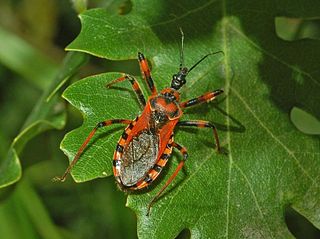
Rhynocoris rubricus is a species belonging to the family Reduviidae, subfamily Harpactorinae.
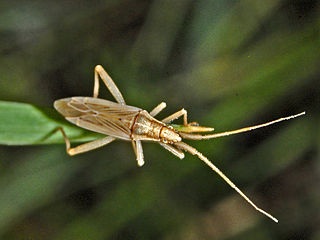
Stenodema holsata is a species of bug from the family Miridae.

Lethocerus patruelis is a giant water bug in the family Belostomatidae. It is native to southeastern Europe, through Southwest Asia, to Pakistan, India and Burma. It is the largest European true bug and aquatic insect. Adult females are typically 7–8 cm (2.8–3.1 in) long, while the adult males are 6–7 cm (2.4–2.8 in).

Meiosimyza rorida is a species of small flies of the family Lauxaniidae.

Macrosaldula scotica is a predatory species of true bug, from the family Saldidae in the order Hemiptera from the western Palearctic.

Psyttala horrida is an insect in the assassin bug genus Psyttala. It is commonly called the horrid king assassin bug or giant spiny assassin bug, and the scientific name is commonly misspelled as Psytalla.
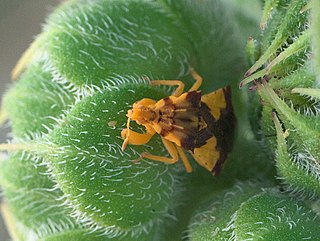
Phymata americana, known as the ambush bug, is a Phymatinae, or ambush bug in the family Reduviidae. It can be found on the flowers of various plants in Central America and North America, where it waits to prey on other insects.

Nagusta goedelii is a species of assassin bugs in the family Reduviidae.

Acanthaspis quinquespinosa is a species of assassin bug found in India, Sri Lanka, Myanmar, Nepal and Tibet. It is a predator, and both nymphs and adults feed on termites, beetles, caterpillars and other insect prey.




